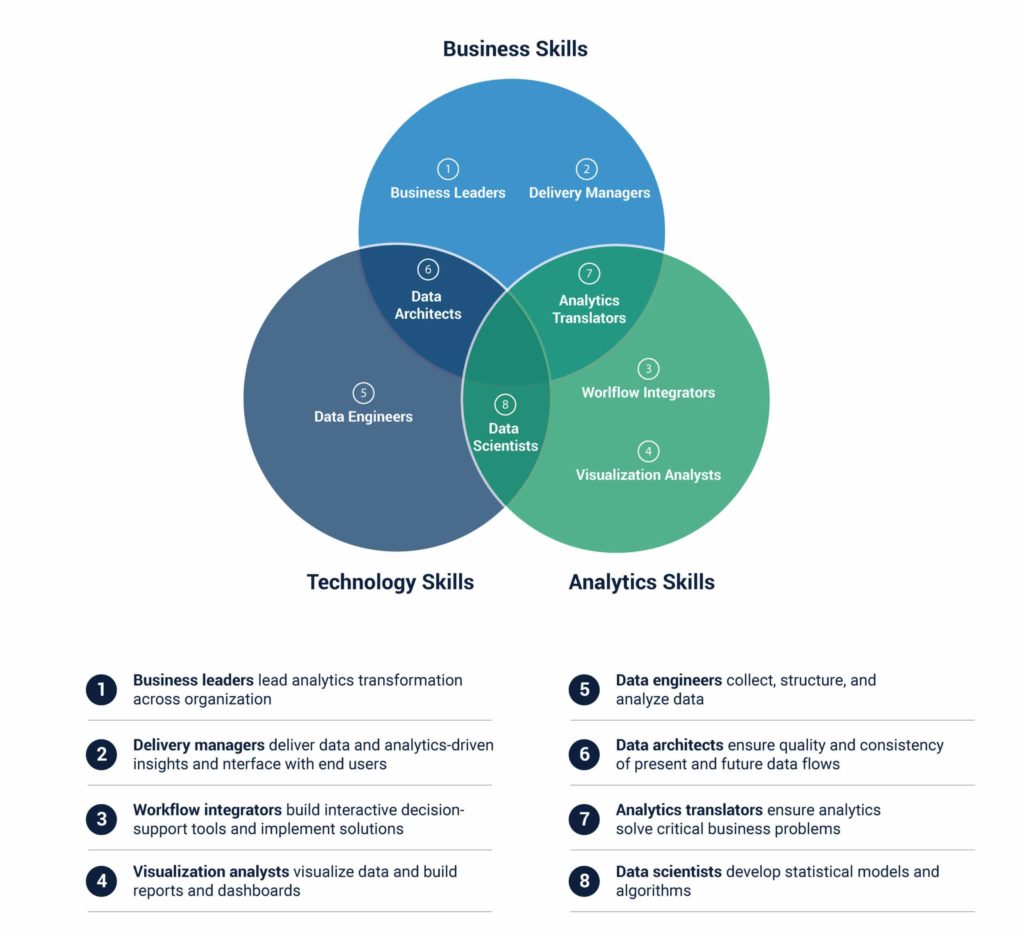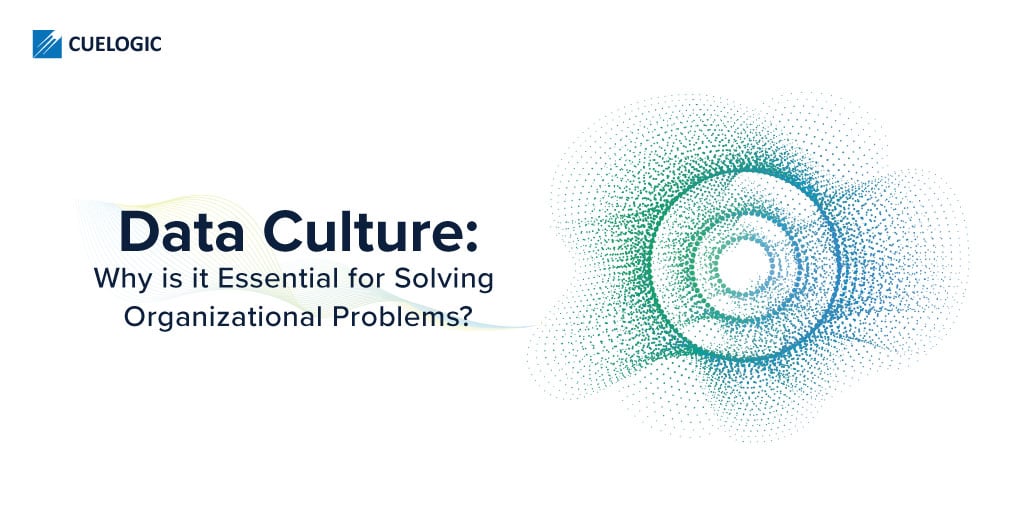The volume of data that individuals and businesses generate is growing rapidly, and with it, the complexity and variety are diversifying too. With so much data all around us, making sense of it and drawing pointed insights capable of adding real value is also fast becoming a challenge. Only companies with the know-how to process their data properly can leverage it to create real value. That’s why more and more businesses are joining the pursuit of data culture. According to a survey by Gartner, chief data officers (CDOs) today consider data-driven culture as their number one priority.
Building data enabled orgnization is key to driving a shift from project-driven isolated use of data to incorporating it at a fundamental operational level. However, moving from instinct-driven to data-driven decision-making isn’t an easy transition. From culture to logistics, there are myriad roadblocks that organizations must navigate to be able to optimally use cultural data to their advantage.
Since data culture is fast becoming a sought-after proposition, let’s take a closer look at what it is, how it can transform your operations, and most importantly, what steps you can take to imbibe it not just in letter but spirit.
What is Data Culture?
Data culture, simply put, means an organizational culture that prioritizes data-driven decision-making. It reflects the collective beliefs and behavior of people within an organization, and as a result of this outlook, the use of data is woven into its very fabric and begins to define its identity, mindset, and operations. Data culture also equips every single individual within an organization to rely on data-driven insights for tackling the most daunting business roadblocks and challenges.
For sake of perspective, let’s juxtapose data cultures with alternatives like hierarchical culture and consensus culture. In hierarchical culture, the onus of decision-making lies at the top, driven by HiPPO (the highest-paid person’s opinion). This limits innovation and can be demoralizing for a majority of the workforce.
In consensus culture, on the other hand, the need to get everyone on board with a new idea can slow the pace of progress because there will invariably be fence-sitters who don’t want to step out of their comfort zone and try something new that may backfire or fail.
In contrast to these two, data culture, coupled with the right technological infrastructure, empowers people to ask questions, challenge ideas, and rely on concrete insights and not just intuition or instinct – be it of one individual or the entire team – to make tough decisions. It fosters an atmosphere of a shared sense of goals and responsibilities, backed by the power of data.
Why is Data Culture Important?
Data culture is important for growth as it enables organizations to make more robust decisions at a much faster pace. According to early research by Forrester, organizations that analyze data to derive insights to base their decision-making on are almost three times more likely to achieve double-digit growth. A report from the MIT CDO and Information Quality Symposium corroborates this with their finding that data-driven culture results in increased revenue, improved profitability and customer service, and enhanced operating efficiencies.
Besides, data cultures are known to promote employee satisfaction – and by extension employee retention – by helping build a work culture driven by logic. This also results in your workforce becoming more invested and committed to organization decisions, mitigating the challenge of employee buy-in.
By backing decisions with data and advanced analytics, you can improve your odds of getting all stakeholders on board wholeheartedly and dramatically boost the odds of any initiative’s success.
What is a Good Data-Driven Culture?
Having the best data analysts and top-of-the-line data infrastructure is not enough to build a good data culture. You cannot merely invest in a high-end Customer Relationship Management (CRM) software and wait for it to magically establish a data-driven culture in your organization.
Data culture cannot be bought, it has to be built, from the top-down, by mixing data science with the right skill, training, accessibility, and management. Of course, the right data infrastructure serves as the bedrock of a strong data culture. However, in the end, the success or failure of transforming into a data-driven organizations boils down to three key factors:
- Data discovery: Giving your employees access to data that enables them to find relevant information in time for critical decision-making
- Data literacy: The ability to interpret and analyze data accurately.
- Data governance: Appropriate management of data to ensure the right people have access to the right data at the right time.
Marrying Talent and Culture
Establishing data culture can be an unrelenting pursuit for many organizations, especially the ones who don’t see that data-driven decision-making is as much about data it is about using the right talent to leverage. It’s vital to see that you cannot foster this model with just mounds of data alone. Or even just analytics, for that matter. The data and the analytics have to align with your end goals to become the foundations of sound decision-making.

The odds of that happening depend solely on the people you work with. To that end, companies must begin by taking a close, critical look at the required skills of their data team. Then, work to get those skill sets onboard by injecting new talent into the workforce as well as upskilling the existing ones. When transforming your teams to align them with your data-driven goals, it’s crucial to look for – or foster – above-average talent.
Being confined to skill sets that everyone else is using would mean getting the same results as everyone else. With the growing demand for advanced analytics, the number of people who can use the right tools and do the right math has also grown exponentially. But can these resources transform these analytics into insights that can help augment business processes? That’s the question you need to answer when marrying data culture and talent.
The key is to look for subject-matter experts in different operational areas who have the ability to grasp the complexities beyond their expertise and communicate with other stakeholders effectively. That’s pivotal in determining whether data culture proves to be a compounding solution or a compounding problem.
How Do You Improve Data Culture?
Rome wasn’t built in a day, and neither can data culture. It takes consistent effort at every level within an organization to truly transform into a data-driven culture. In doing so, being mindful of the following parameters can boost your odds of success:

Assess Organization Readiness
The biggest roadblocks in building a data culture are not technical but cultural. It’s not the lack of data scientists or infrastructure that impedes the transition but conscious or subconscious resistance by your team members. Before you decide to inject data culture into the decision-making process, see if your organization is ready for this change. If not, lay the groundwork for it before you leap.
Clean Up Your Data
The next step is to improve your data quality to ensure that relevant data is available to your employees when they most need it. Work with data scientists and leverage tools like data mining and machine learning to clean up and structure your data.
Make Data Accessible
Once the data has been reorganized, the next order of business is to ensure that it is readily accessible to your employees. All the relevant data and information must be quick to find and easy to understand. This entails making data governance less complex and more democratized.
Enhance Data Literacy Across the Board
You may have specialists to analyze data but it is your employees who need to decode and use it for making more robust decisions. That’s why data culture cannot be established unless it is supported by data literacy programs for the end-users.
Data Cultures Percolate from the Top
One common theme in companies with strong data cultures is that the change begins at the top. The top managers lead by example, by anchoring their own decision-making to astute data insights. The practice naturally percolates downwards, as employees have to adopt the approach and language of their seniors to be effective and taken seriously.
Integrate Data Analysts with Business Operations
You cannot hope to establish data-driven decision-making if your analysts operate in isolation, without any knowledge of how their endeavors impact business operations and vice-versa. The success of this transition rests on creating porous boundaries between data analysts and decision-makers, integrating them into the business side as closely as possible.
Simplify Data Science
Data science and its outcomes can often be too complex for employees with limited technical know-how to comprehend in entirety. It is imperative to not lose focus on the importance of making data concepts simple and robust rather than brittle and fancy.
Build Detailed Metrics
Creating detailed metrics on which to measure the success of your data culture can help you quantify the outcomes and make adjustments as need be. Here too, leaders can play a key role in defining what metrics to measure. The rest of the workforce will quickly align themselves accordingly.
Focus Data Culture on Employees, not Customers
Remember that data fluency is for your employees, not your customers. To get them excited about this proposition enough to be invested in it, data culture must not be presented as an abstract idea but in the form of concrete, tangible benefits your workforce can get out of it – saving time, improving efficiency, reducing reworks, and so on. Once you do that, data culture becomes a choice, not a chore.
The Way Forward
Data culture can prove to be the tool you need to expand your horizons without the fear of risk holding you back. Since every idea and hypothesis is supported by analytical insights, you can take new leaps with confidence. To bring about this change, leaders must set the precedence of rooting decisions in data.
